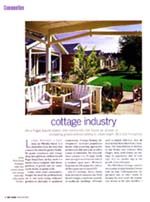The following is the text from the article "Cottage Industry" by Linda
Humphrey that appeared in the March/April 2000 Metropolitan Home
Magazine

cottage industry
On a Puget Sound island, one
community has found an answer
to increasing growth without
adding to urban blight
Langley, Washington, a beach town on Whidbey Island, is a short drive from the ferry that connects the island to greater Seattle. Its quaint restaurants and vintage shops that spill down a hillside toward Puget Sound have, in fact, made it a tourist mecca, complete with thorny problems of growth and the consequent decline in quality of life.
Unlike some small communities, Langley has faced the problem head-on. A new local zoning ordinance provides an alternative to apartment construction: "Cottage Housing Development" increases population density while preserving appropriate architectural style and scale as well as a sense of community. The new ordinance permits 4 to 12 single family units arranged on at least two sides of a common open space. Maximum footprints are 650 square feet, with total floor space not to exceed 975.
And it's working. Three blocks from the hub of commerce sits Third Street Cottages, a watercolor pastiche of small-scale dwellings. Although each is slightly different, they all seem to have been lifted from a storybook. The brainchildren of developer Jim Soules and architect Ross Chapin, these small houses are nostalgic in appearance only. In concept, they are another step in the growth of new urbanism.
The Third Street Cottages community consists of eight detached homes built on four 7,400-square-foot single-family lots. In other words, by keeping the units small, the population density of the land doubled without creating multifamily buildings. Typically, the layout of the homes consists of a kitchen opening onto a living/dining area with a master suite on the first floor and a second-story loft.
With nine-foot ceilings, large front porches, individualized lofts, built-in niches and carefully planned storage, the 975-square-foot houses are extremely efficient. Residents have a ninth building (with a workshop, roof terrace and storage lockers) so more of the space in individual homes can be given over to living space.
The cottages were sold as condominiums at prices ranging from $143,900 to $149,000, plus a monthly maintenance fee of $160. In contrast, the price for an average (1,500-square-foot) house in Langley ranges from $189,000 to $250,000 (waterfront properties are considerably higher); first Third Street cottage to go on the resale market fetched $178,500; a second, larger one, went on the market at $205,000.
Most of the units are owned by single adults or couples. One of the first purchasers was Ann Hartley, a 65-year-old retired librarian, who moved from a two-story home. She liked it so much she persuaded a friend to move in next door. Greater Seattle residents Marty Fernandez and wife Peggy Moe use their cottage as a getaway with their 3-year-old daughter Sophie.
"We're not trying to appeal to isolationists," Chapin stresses, "We're in this together to foster a renewed sense of caring for each other."
Obviously, smaller houses that require fewer materials to build and less energy to heat and cool are better for the environment. The Third Street Cottages also made use of resource-efficient materials in construction, from reclaimed interior paneling to exteriors clad with fiber-cement siding.
In addition to individualized exteriors, the cottages bear the stamp of their owners indoors. The kitchen cabinets were installed, but flooring and counter surfaces were left as personal decisions. Graphic artist Marty Fernandez used commercial vinyl composition tile in his kitchen, installing it not only on the floors, but in patterns on the counter and backsplash.
As small cities like Langley struggle with growth issues, they become rife with overdevelopment, which threatens to ruin them. A city planning commission that values alternative solutions and sensitive developers like Chapin and Soules can provide expansion that enhances community while providing reasonable and attractive housing.





